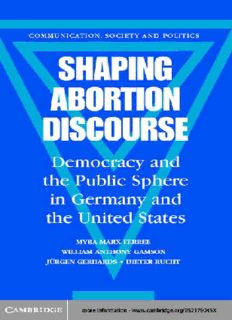
Shaping Abortion Discourse: Democracy and the Public Sphere in Germany and the United States PDF
Preview Shaping Abortion Discourse: Democracy and the Public Sphere in Germany and the United States
This page intentionally left blank Shaping Abortion Discourse Democracy and the Public Sphere in Germany and the United States Using controversy over abortion as a lens through which to compare the political process and the role of the media in these two very differ- ent democracies, this book examines the contest over meaning that is being waged by social movements,political parties,churches,and other social actors.Abortion is a critical battleground for debates over social values in both countries,but the constitutional premises on which argu- ments rest differ,as do the strategies that movements and parties adopt and the opportunities for influence that are open to them.By examin- ing how these debates are conducted, and by whom, in light of the normative claims made by democratic theorists,the book also offers a means ofjudging how well either country lives up to the ideals ofdemo- cratic debate in practice. Myra Marx Ferree is Professor of Sociology at the University of Wisconsin–Madison.She is the co-author ofControversy and Coalition: The New Women’s Movement Across Three Decades ofChange(2000) and co-editor of Re-visioning Gender (1998). William Anthony Gamson is Professor of Sociology and co-directs the Media Research and Action Project (MRAP) at Boston College. He is the author of Talking Politics (1992) and The Strategy of Social Protest (2nd edition,1990). Jürgen Gerhards is Professor of Sociology at the University of Leipzig. His many publications include Die Vermessung kultureller Unterschiede. Deutschland und USA im Vergleich (Measuring Cultural Differences: Germany and the U.S.in a Comparative Perspective) (2000). Dieter Rucht is Professor of Sociology at the Social Science Research Center, Berlin. His many publications include Jugendkulturen, Politik und Protest (Youth Cultures,Politics,and Protest) (2000). COMMUNICATION, SOCIETY AND POLITICS Editors W.Lance Bennett,University ofWashington Robert M.Entman,North Carolina State University Editorial Advisory Board Larry M.Bartels,Princeton University Jay G.Blumler,Emeritus,University ofLeeds Daniel Dayan,Centre National de la Rechereche Scientifique,Paris Doris A.Graber,University ofIllinois at Chicago Paolo Mancini,Universita di Perugia Pippa Norris,Kennedy School ofGovernment,Harvard University Barbara Pfetsch,Wissenschaftszentrum Berlin Für Sozialforschung Philip Schlesinger,University ofStirling David L.Swanson,University ofIllinois at Urbana-Champaign Gadi Wolfsfeld,Hebrew University ofJerusalem John Zaller,University ofCalifornia,Los Angeles Politics and relations among individuals in societies across the world are being transformed by new technologies for targeting individuals and sophisticated methods for shaping personalized messages. The new technologies challenge boundaries of many kinds – between news,information,entertainment,and advertising;between media,with the arrival ofthe World Wide Web;and even between nations.Communication,Society and Politicsprobes the political and social impacts ofthese new communication systems in national,comparative, and global perspective. Shaping Abortion Discourse DEMOCRACY AND THE PUBLIC SPHERE IN GERMANY AND THE UNITED STATES Myra Marx Ferree William Anthony Gamson University ofWisconsin,Madison BostonCollege Jürgen Gerhards Dieter Rucht Universität Leipzig Wissenschaftszentrum Berlin The Pitt Building, Trumpington Street, Cambridge, United Kingdom The Edinburgh Building, Cambridge CB2 2RU, UK 40 West 20th Street, New York, NY 10011-4211, USA 477 Williamstown Road, Port Melbourne, VIC 3207, Australia Ruiz de Alarcón 13, 28014 Madrid, Spain Dock House, The Waterfront, Cape Town 8001, South Africa http://www.cambridge.org ©Myra Marx Feree, William Anthony Gamson, Jürgen Gerhards, Dieter Rucht 2004 First published in printed format 2002 ISBN 0-511-03134-3 eBook (Adobe Reader) ISBN 0-521-79045-X hardback ISBN 0-521-79384-X paperback Contents Tables and Figures page ix Foreword by Friedhelm Neidhardt xi Preface xv Glossary xix Part I: Introduction 1 Two Related Stories 3 2 Historical Context 24 3 Methods 45 Part II: Major Outcomes 4 The Discursive Opportunity Structure 61 5 Standing 86 6 Framing 105 Part III: Representing Different Constituencies 7 Representing Women’s Claims 131 8 Representing Religious Claims 154 9 Representing the Tradition of the Left 179 Part IV: The Quality ofAbortion Discourse 10 Normative Criteria for the Public Sphere 205 11 Measuring the Quality of Discourse 232 vii C 12 Metatalk 255 13 Lessons for Democracy and the Public Sphere 286 Methodological Appendix 305 References 325 Index 339 viii
Description: